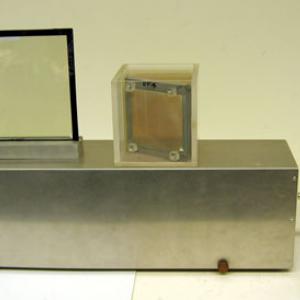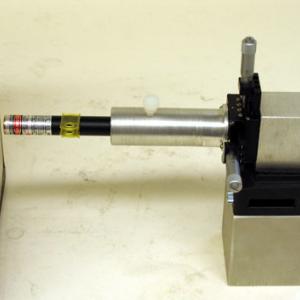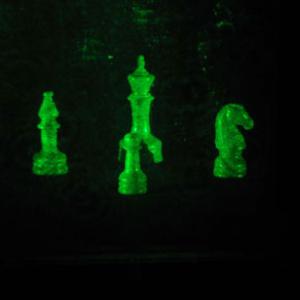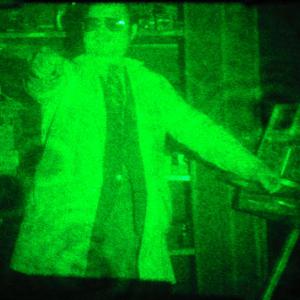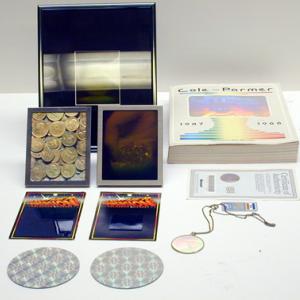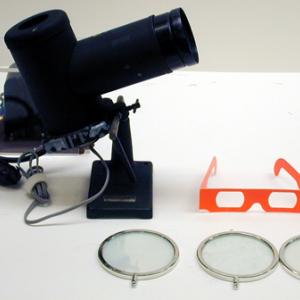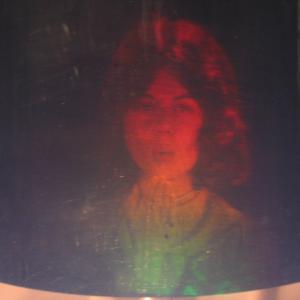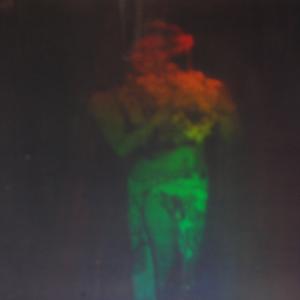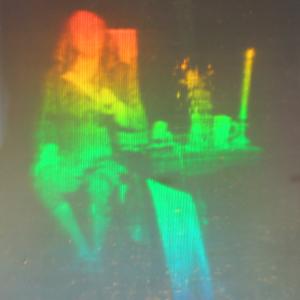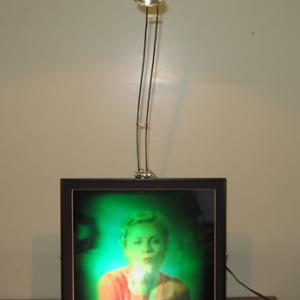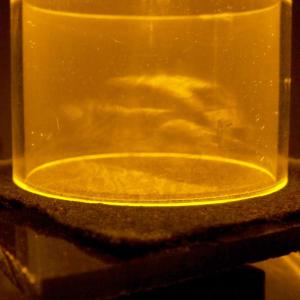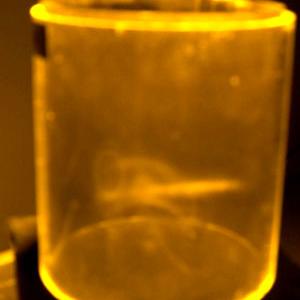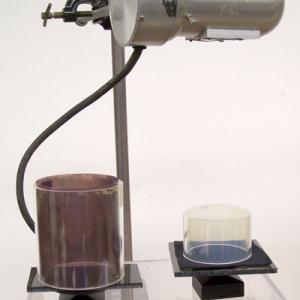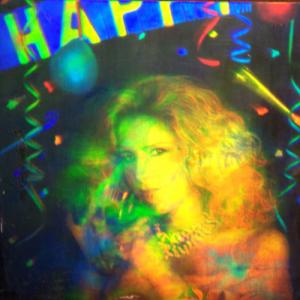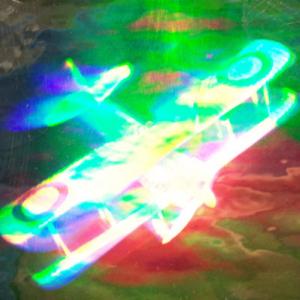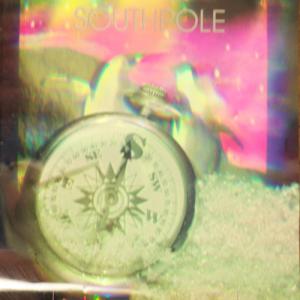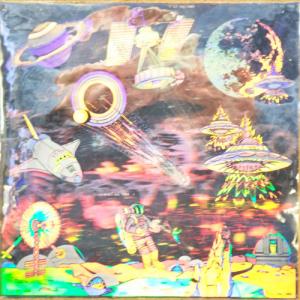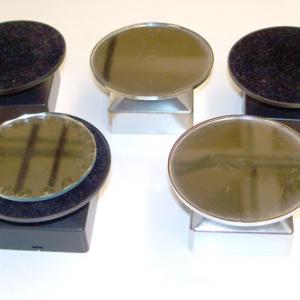College of Liberal Arts & Sciences
6Q10.10 - Holography
Set up as shown with the laser pointed through the diverging lens. Insert a plastic plate into the unit and observe the images.
Holding a 100 watt light bulb in front of the holograms in the frames will enhance the images and movements with position. The clock hologram should have a total of 8 different position of the minute hand.
Set the parallel light source up as shown and hold the holographic prisms in the beam and observe.
"The Kiss" is a famous hologram showing a young girl blowing a kiss and then winking as you move across the front of the hologram. This hologram is also unique because if you rotate the film by 180 degrees top to bottom you will see a totally different hologram. In this case it is a hologram of a girl doing the Hula.
We also have a nice large hologram of "Ben Franklin" sitting in his laboratory.
"Sarah" is another famous hologram much like "The Kiss" except the hologram is almost picture quality as if you are viewing it in normal lighting.
Place the 360 degree holograms onto the battery powered rotating platforms. The old sodium light source works best for these holograms. Place it about 12 to 18 inches above the hologram and adjust the position of the holograms under the lamp to get the brightest and sharpest image. The two holograms we have are images of a VW Beetle and an antique artillery cannon.
An assortment of holograms on metal foil can also be shown. They are, Girl at a Party, Clown Face, Biplane, Compass, and Penguins, Aliens and Spacecraft.
The hologram that was made at UNI shows a large decorative ceramic stein.
The holographic lab kit is from UNI and is a wonderful way to do many optics experiments!
- Chris Chiaverina, "Litholo Holography: Apparatus Review", TPT, Vol. 48, #8, Nov. 2010, p. 551.
- Chris Chiaverina, "The Doctor is In", TPT, Vol. 41, #5, May 2003, p. 270.
- Jack Higbie, "Depth of Field in Hologram Images", TPT, Vol. 35, #7, Oct. 1997, p. 418.
- Mark L. Biermann and Brent L. Hild, "Image Quality and Simplicity in Basic Holography", TPT, Vol. 35, #7, Oct. 1997, p. 408.
- Thomas L. Rokoske, "A New Perspective for Viewing Holograms", TPT, Vol. 30, #9, Dec. 1992, p. 557.
- H. Dittmann and W. B. Schneider, "Simulated Holograms", TPT, Vol. 30, #4, Apr. 1992, p. 244.
- Thomas C. Altman, "Holography and Interferometry", TPT, Vol. 30, #4, Apr. 1992, p. 220.
- Thomas D. Rossing, "Holographic Interferometry of Vibrating Objects", TPT, Vol. 30, #4, Apr. 1992, p. 219.
- Dale W. Olson, "Real and Virtual Images using a Classroom Hologram", TPT, Vol. 30, #4, Apr. 1992, p. 202.
- Philip Sadler, "Projecting Spectra for Classroom Investigation", TPT, Vol. 29, #7, Oct. 1991, p. 423.
- Thomas C. Altman, "Pre‐Newtonian Holograms or How to Make Holograms Without all the Bother of Inertia and Vibrations", TPT, Vol. 26, #4, Apr. 1988, p. 223.
- Michael Linthwaite and Christopher Shimmens, "Simple Method of Producing Good-Quality Holograms Without the Need for Expensive Equipment", TPT, Vol. 25, #6, Sept. 1987, p. 382.
- Robert E. Latham, "Holography in the Science Classroom", TPT, Vol. 24, #7, Oct. 1986, p. 395.
- Hartmut Spetzleer, "Interesting Example of Holographic Interferometry", TPT, Vol. 24, #2, Feb. 1986, p. 80.
- Y. P. Hwu, E. H. Bunn, C. L. Brown, and D. L. Hoosier, "Single-Beam Holographic Technique on Membrane Vibration", TPT, Vol. 19, #9, Dec. 1981, p. 619.
- Y. P. Hwu, "More Holographic Interference Fringe Patterns by Thermal Deformation", TPT, Vol. 18, #8, Nov. 1980, p. 602.
- J. H. Altamirano and S. Gel-Sandoval, "A Method to Set the Intensity Ratio in Holography", TPT, Vol. 18, #4, Apr. 1980, p. 299.
- Yeu-Pyng Hwu, "Holographic Interference Fringes by Thermal Deformation", TPT, Vol. 18, #4, Apr. 1980, p. 295.
- T. H. Jeong, "The One-Beam Transmission Hologram", TPT, Vol. 18, #2, Feb. 1980, p. 129.
- Larry D. Kirkpatrick and Mac Rugheimer, "A Holographic Road Show", TPT, Vol. 17, #1, Jan. 1979, p. 25.
- W. Kent Schubert and Carl R. Throckmorton, "Making a 360° Hologram", TPT, Vol. 13, #5, May 1975, p. 310.
- Barry Leonard Werner, "Made a Hit!", TPT, Vol.13, #5, May 1975, p. 261.
- Bradley A. Strin, "Recording 360 degree holograms in the undergraduate laboratory", Vol. 43, #4, April 1975, p. 297.
- Winston E. Kock, "Sound Visualization and Holography", TPT, Vol. 13, #1, Jan. 1975, p. 14.
- "360° Holograms... A Simple Way; and a Better Way", TPT, Vol. 12, #2, Feb. 1974, back cover page.
- Ting-Chung Poon, "On the Fundamentals of Optical Scanning Holography", AJP, Vol. 76, #8, Aug. 2008, p. 738.
- L. Repetto, F. Pellistri, E. Piano and C. Pontiggia, "Gabor's Hologram in a Modern Perspective", AJP, Vol. 72, #7, July 2004, p. 964.
- Vincent Toal, "A Simple Approach to Phase Holography", AJP, Vol. 71, #9, Sept. 2003, p. 948.
- David J. McGee and Mark D. Matlin, "Photorefractive Polymers: Materials Science, Thin-Film Fabrication, And Experiments In Volume Holography", AJP, Vol. 69, #10, Oct. 2001, p. 1055.
- Grady J. Koch and Mulugeta Petros, "A Simple Overhead Denisyuk Configuration for Making Reflection Holograms with a Diode Laser", AJP, Vol. 66, #10, Oct. 1998, p. 933.
- D. W. Olson, "The Elementary Plane-Wave Model for Hologram Ray Tracing", AJP, 57, #5, May 1989, p. 445.
- D. W. Olson, "The Abramson Ray-Tracing Method for Holograms", AJP, Vol. 57, #5, May 1989, p. 439.
- Jacob W. Huang and Pin-yi Zhang, "A Simple Method of Making a One-Step Rainbow Hologram with a Beaker of Water", AJP, Vol. 57, #2, Feb. 1989, p. 133.
- Xiangxi Chen, Jacob Huang, and Eddie Loh, "Computer-Assisted Teaching of Optics", AJP, Vol. 55, #12, Dec. 1987, p. 1129.
- Simon George, Mike Truman, and M. V. R. K. Murty, "Holographic Gratings for the Physics Laboratory", AJP, Vol. 55, #11, Nov. 1987, p. 1015.
- Jacques E. Ludman, "Approximate Bandwidth and Diffraction Efficiency in Thick Holograms", AJP, Vol. 50, #3, Mar. 1982, p. 244.
- J. W. Rudmin, G. R. Taylor, P. M. Hand, J. N. Ashworth, and P. H. Wehr, "Simple Ultra-Low-Cost Undergraduate Holography Using a Modified Michelson Interferometer", AJP, Vol. 48, #9, Sept. 1980, p. 746.
- S. T. Hsue, B. L. Parker, M. Monahan, "360º Reflection Holography", AJP, Vol. 44, #10, Oct. 1976, p. 927.
- Hsuan Chen, Paul H. Ruterbusch, "Single Beam Holography", AJP, Vol. 47, #12, Dec. 1979, p. 1042.
- William E. Tagliaferro and P. L. Lee, "Holographic Interferometry for Pure Rotation", AJP, Vol. 46, #1, Jan. 1978, p. 46.
- Mary E. Cox and Kerry J. Vahala, "Image Plane Holograms for Introductory Physics Students", AJP, Vol. 46, #8, Aug. 1978, p. 861.
- Mac Rugheimer and Larry D. Kirkpatrick, "Demonstration Holograph for Comparing an Image Lens and Real Lens", AJP, Vol. 45, #11, Nov. 1977, p. 1027.
- R. J. Annulli and J. T. Ziewaca, "Single‐Beam 360° Holograms", AJP, Vol. 45, #5, May 1977, p. 493.
- Peter K. Glanz, Nasif Haskell, "A Versatile Beam Splitter for Holographers", AJP, Vol. 44, #7, July 1976, p. 712.
- Alan G. Porter, "An Elementary Introduction to Practical Holography", AJP, Vol. 43, #8, Nov. 1975, p. 954.
- Tung H. Jeong, "Geometric Model for Holography", AJP, Vol. 43, #8, Aug. 1975, p. 714.
- David E. Bellamy, "A Simple Method of Hologram Verification", AJP, Vol. 43, #2, Feb. 1975, p. 185.
- M. Parker Givens, "Image Location and Magnification in Holography", AJP, Vol. 40, #9, Sept. 1972, p. 1311.
- M. Parker Givens, "Introduction to Holography", AJP, Vol. 35, #11, Nov. 1967, p. 1056.
- Leslie T. Long and John A. Parks, "Inexpensive Holography", AJP, Vol. 35, #8, Aug. 1967, p. 773.
- Sung Chang, "Neutron Holography Makes its Debut", Physics Today, Vol. 69, #12, Dec. 2016, p. 24.
- Sung Chang, "Digital Holography Takes to the Skies", Physics Today, Vol. 68, #12, Dec. 2015, p. 21.
- Mark Wilson, "Holograms Tie Optical Vortices in Knots", Physics Today, Vol. 63, #3, Mar. 2010, p. 18.
- Stephen G. Benka, "Holography in Quantitative Biology", Physics Today, Vol. 61, #10,Oct. 2008, p. 24.
- Pal Greguss, "Acoustical Holography", Physics Today, Vol. 27, #10, Oct. 1974, p. 42.
- David Howard, "400 Years of Holograms: The History of Illusion", Popular Mechanics, Vol. 192, #7, July/Aug. 2015, p. 62.
- Jearl Walker, "The Amateur Scientist: How to Stop Worrying about Vibration and Make Holograms Viewable in White Light", Scientific American, Vol. 260, #5, May 1989, p. 134.
- Jearl Walker, "The Amateur Scientist: Rainbow Holograms, Unlike Conventional Ones, Can Be Observed in Ordinary Light", Scientific American, Vol. 255, #3, Sept. 1986, p. 114.
- Jearl Walker, "The Amateur Scientist: Easy Ways to Make Holograms and View Fluid Flow, and More Funny Fluids", Scientific American, Vol. 242, #2, Feb. 1980, p. 158.
- "O-485: Hologram - Plane & Multiplex", DICK and RAE Physics Demo Notebook.
- "O-490: Making Holograms", DICK and RAE Physics Demo Notebook.
- Wallace A. Hilton, "I-14", Experiments in Optical Physics, p. 40.
- Robert Ehrlich, "Q.13, Hologram Eyeglasses", Turn the World Inside Out, p. 205.
- T. Kallard, "Some Applications of Holography", Exploring Laser Light, p. 255.
- T. Kallard, "Producing Fourier Holograms", Exploring Laser Light, p. 252.
- T. Kallard, "Random Bias Holograms", Exploring Laser Light, p. 251.
- T. Kallard, "360 Degrees Holography", Exploring Laser Light, p. 248.
- T. Kallard, "Properties of Holograms", Exploring Laser Light, p. 223.
- T. Kallard, "Holography", Exploring Laser Light, p. 221.
- Jearl Walker, "6.109, Anticounterfeiting: Optically Variable Devices", The Flying Circus of Physics Ed. 2, p. 286.
- Frank DeFreitas, Alan Rhody, and Steve Michael, "A Brief History", Shoebox Holography - A Step-By-Step Guide to Making Holograms Using Inexpensive Semiconductor Diode Lasers, p. 25, 54, 107.
- "Holography", The New Illustrated Science and Invention Encyclopedia, p. 1203 - 1209.
- Isaac Asimov, "Trapping the Rainbow", Fantasy and Science Fiction Magazine, p. 131.
- Readers Digest, "Holograms: Three-Dimensional Pictures on a Flat Surface", How in the World, p. 229.
- T. D. Rossing and C. J. Chiaverina, "Experiment 9.3, Making A Cylindrical Hologram", Light Science, Physics and Visual Arts, p. 416.
- T. D. Rossing and C. J. Chiaverina, "Experiment 9.2, Making A Transmission Hologram", Light Science, Physics and Visual Arts, p. 413.
- T. D. Rossing and C. J. Chiaverina, "Experiment 9.1, Making A Reflection Hologram", Light Science, Physics and Visual Arts, p. 412.
- T. D. Rossing and C. J. Chiaverina, "Home and Classroom Demonstration", Light Science, Physics and Visual Arts, p. 224.
- T. D. Rossing and C. J. Chiaverina, "Holography", Light Science, Physics and Visual Arts, p. 203.
- Brian Jones and Matt Fackelman, "Rainbow Glasses", Don't Forget the Duct Tape, p. 105 - 108.
Disclaimer: These demonstrations are provided only for illustrative use by persons affiliated with The University of Iowa and only under the direction of a trained instructor or physicist. The University of Iowa is not responsible for demonstrations performed by those using their own equipment or who choose to use this reference material for their own purpose. The demonstrations included here are within the public domain and can be found in materials contained in libraries, bookstores, and through electronic sources. Performing all or any portion of any of these demonstrations, with or without revisions not depicted here entails inherent risks. These risks include, without limitation, bodily injury (and possibly death), including risks to health that may be temporary or permanent and that may exacerbate a pre-existing medical condition; and property loss or damage. Anyone performing any part of these demonstrations, even with revisions, knowingly and voluntarily assumes all risks associated with them.
